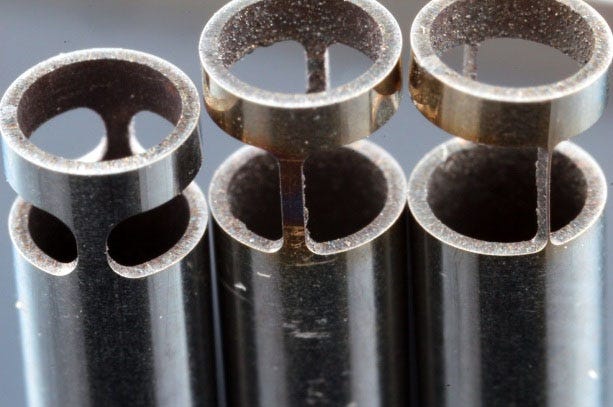February 27, 2014
In minimally invasive and natural-orifice transluminal endoscopic surgery, doctors require articulation in surgical tool tips to improve dexterity and gain access to hard-to-reach areas. Because surgical tool tips generally afford only straight-line access, articulation adds an extra degree of freedom. While as much as 90° of articulation is desirable, assembling conventional hinged joints at this scale is challenging. To overcome the difficulty of creating endoscopic tool tips affording the required level of articulation, researchers at Penn State University (University Park) have developed a compliant articulation structure using nitinol to achieve a large deflection angle and large force in a compact size.
|
Three nitinol tubes were processed using a Miyachi Unitek laser tube cutter. The thin features exhibit oxidation resulting from heat effects. |
To produce a surgical tool tip with as much as 90° of articulation, the researchers needed to use a highly flexible, biocompatible material that can withstand very large deformations. However, a preliminary analysis indicated that the articulation angles achieved using stainless steel are quite small. Instead of stainless steel, they therefore determined that they could expect to obtain an appropriate articulation angle and sufficient blocked force using nitinol in the compliant articulation structure. "We are taking advantage of the superelasticity of nitinol, which means that in a certain range, we can achieve a very large deformation for a small increase in stress," explains Mary I. Frecker, professor of mechanical engineering and bioengineering and director of the Learning Factory at Penn State University.
"Large force is needed to be able to perform useful surgical tasks such as grasping or dissecting tissue," Frecker remarks. "At the same time, a large articulation angle is needed to be able to reach beyond the straight line of the surgical tool tip. These two objectives compete with each other, so we have used finite element analysis and optimization to find the design with the best tradeoff."
The conflicting design requirements were modeled in a finite element analysis using two performance metrics: the free articulation angle and the blocked force. In the analysis, the articulation angle was defined as the maximum angle that can be achieved without exceeding the material stress limit, and the blocked force measured the ability of the compliant articulation structure to withstand or induce an external force.
Find out more about the medical device industry and medical device components at BIOMEDevice, March 26-27, 2014 in Boston. |
Because of its hardness and its sensitivity to thermal and mechanical effects, processing nitinol can be difficult to work with, according to Frecker. While it can be micromachined using a variety of manufacturing methods--including milling, drilling, sawing, EDM, and photochemical etching--the researchers opted for pulsed laser processing because of its high processing speeds and flexibility.
"There are real challenges in using conventional machining techniques to produce features at the scale required for endoscopic surgical procedures," Frecker says. "As such, many medical device suppliers are investigating laser micromachining and microwelding. In addition, a number of manufacturers are successfully using these technologies in production."
Among the laser machines that the researchers used to process nitinol-based articulation structures was the Sigma laser tube cutter from Miyachi Unitek, a 1064-nm, 200-W single-mode fiber laser system featuring a repetition rate of 1.5 kHz and a pulse energy of 50 mJ. The system was equipped with a 500-µm output nozzle and supplied with a 55-psi coaxially driven flow of O2 assist gas. Producing a clean, smooth cut in less than 5 sec, this equipment was able to process nitinol tubes with a minimal heat-affected zone and surface roughness on the order of 5 µm. The system's short focal length and single-mode beam profile enabled the researchers to achieve a small spot size, helping to increase fluence and localize heat effects.
"This is a relatively new technology, and people are still interested in learning how to optimize the process to minimize detrimental material effects and maximize cost effectiveness," Frecker comments. "Parameters such as wavelength, pulse duration, pulse energy, and ancillary processes during laser manufacturing will impact the superelastic properties of advanced alloys such as nitinol."
Bob Michaels is senior technical editor at UBM Canon.
About the Author(s)
You May Also Like



